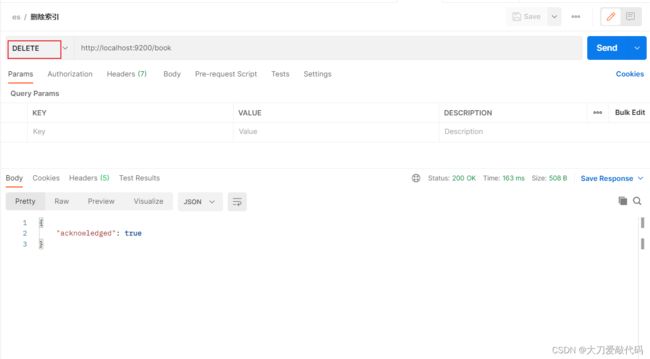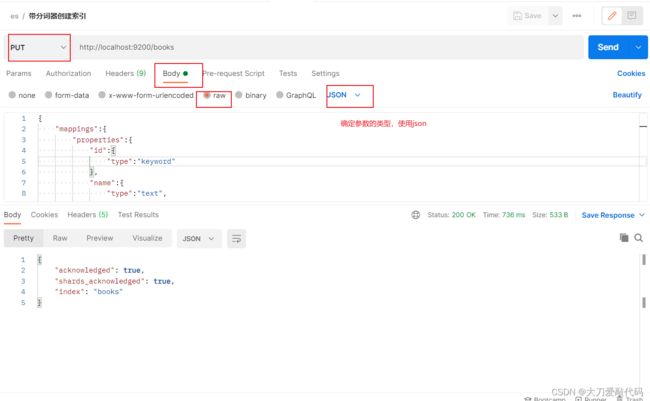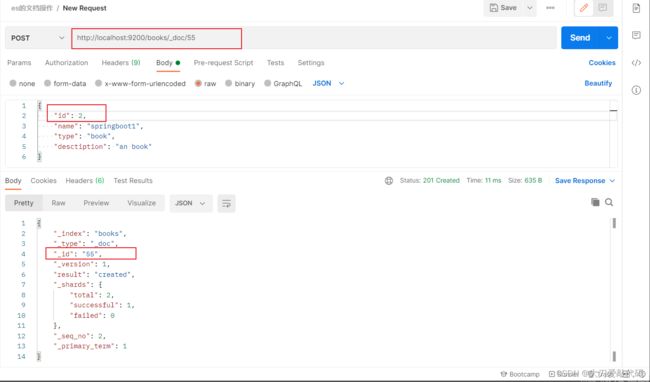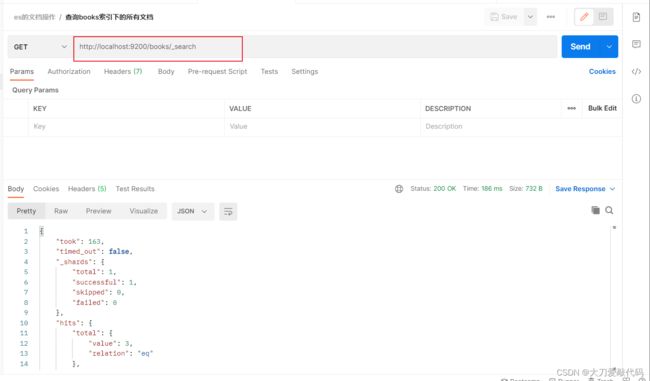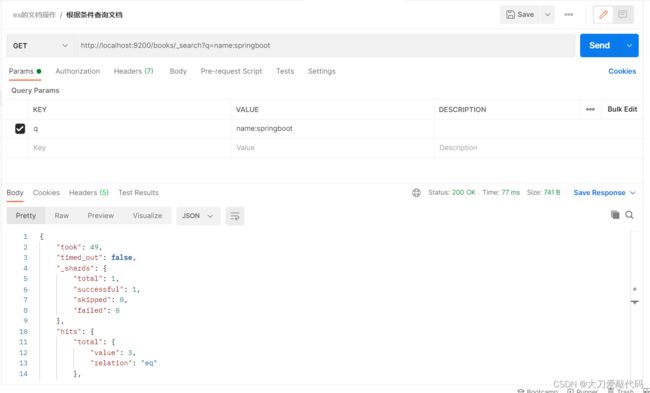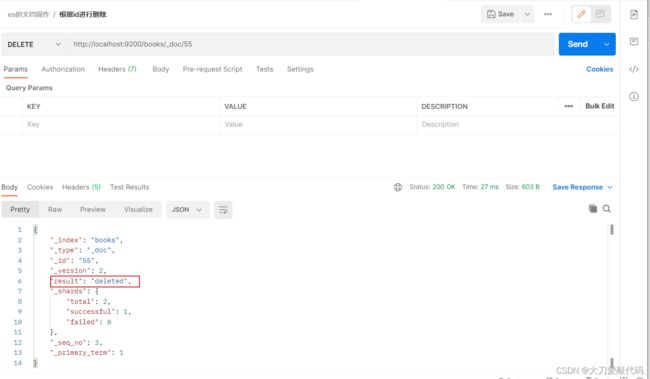ES(Elasticsearch)的基本使用
一、常见的NoSQL解决方案
1、redis
Redis是一个基于内存的 key-value 结构数据库。Redis是一款采用key-value数据存储格式的内存级NoSQL数据库,重点关注数据存储格式,是key-value格式,也就是键值对的存储形式。与MySQL数据库不同,MySQL数据库有表、有字段、有记录,Redis没有这些东西,就是一个名称对应一个值,并且数据以存储在内存中使用为主。redis的基本使用
2、mongodb
- MongoDB可以在内存中存储类似对象的数据并实现数据的快速访问。
- 使用Redis技术可以有效的提高数据访问速度,但是由于Redis的数据格式单一性,无法操作结构化数据,当操作对象型的数据时,Redis就显得捉襟见肘。在保障访问速度的情况下,如果想操作结构化数据,看来Redis无法满足要求了,此时需要使用全新的数据存储结束来解决此问题,即MongoDB技术。mongodb的基本使用
3、ES(Elasticsearch)
- ES(Elasticsearch)是一个分布式全文搜索引擎,重点是全文搜索。
二、ES的使用
ES简介
- es是由Apache开源的一个兼有搜索引擎和NoSQL数据库功能的系统,其特点主要如下。
-
- 基于Java/Lucene构建,支持全文搜索、结构化搜索(应用于加速数据的查询)
-
- 低延迟,支持实时搜索
-
- 分布式部署,可横向集群扩展
-
- 支持百万级数据
-
- 支持多条件复杂查询,如聚合查询
-
- 高可用性,数据可以进行切片备份
-
- 支持Restful风格的api调用
-
全文搜索
-
全文搜索的理解:
比如用户要在淘宝上买一本书(Java开发),那么他就可以以Java为关键字进行搜索,不管是书名中还是书的介绍中,甚至是书的作者名字,只要包含java就作为查询结果返回给用户查看。这就可以理解为全文搜索。- 搜索的条件不再是仅用于对某一个字段进行比对,而是在一条数据中使用搜索条件去比对更多的字段,只要能匹配上就列入查询结果,这就是全文搜索的目的。而ES技术就是一种可以实现上述效果的技术。
-
全文搜索的实现:
要实现全文搜索的效果,不可能使用数据库中like操作去进行比对,这种效率太低了。ES设计了一种全新的思想,来实现全文搜索。具体操作过程如下:-
- 将被查询的字段的数据全部文本信息进行拆分,分成若干个词
- 例如“中华人民共和国”就会被拆分成三个词,分别是“中华”、“人民”、“共和国”,此过程有专业术语叫做分词。分词的策略不同,分出的效果不一样,不同的分词策略称为分词器。
-
- 将分词得到的结果存储起来,对应每条数据的id
- 例如id为1的数据中名称这一项的值是“中华人民共和国”,那么分词结束后,就会出现“中华”对应id为1,“人民”对应id为1,“共和国”对应id为1
- 例如id为2的数据中名称这一项的值是“人民代表大会“,那么分词结束后,就会出现“人民”对应id为2,“代表”对应id为2,“大会”对应id为2
- 此时就会出现如下对应结果,按照上述形式可以对所有文档进行分词。需要注意分词的过程不是仅对一个字段进行,而是对每一个参与查询的字段都执行,最终结果汇总到一个表格中
分词结果关键字 对应id 中华 1 人民 1,2 共和国 1 代表 2 大会 2 -
- 当进行查询时,如果输入“人民”作为查询条件,可以通过上述表格数据进行比对,得到id值1,2,然后根据id值就可以得到查询的结果数据了。
-
-
上述过程中分词结果关键字内容每一个都不相同,作用有点类似于数据库中的索引,是用来加速数据查询的。
- 但是数据库中的索引是对某一个字段进行添加索引,而这里的分词结果关键字不是一个完整的字段值,只是一个字段中的其中的一部分内容。并且索引使用时是根据索引内容查找整条数据,全文搜索中的分词结果关键字查询后得到的并不是整条的数据,而是数据的id,要想获得具体数据还要再次查询,因此这里为这种分词结果关键字起了一个全新的名称,叫做倒排索引。
ES的应用场景
- ES作为全文检索的搜索引擎,在以下几个方面都存在着相应的应用:
-
- 监控。针对日志类数据进行存储、分析、可视化。针对日志数据,ES给出了ELK的解决方案。其中logstash采集日志,ES进行复杂的数据分析,kibana进行可视化展示。
-
- 电商网站。用于商品信息检索。
-
- Json文档数据库。用于存放json格式的文档
-
- 维基百科。提供全文搜索并高亮关键字
-
Es的windows版安装
-
windows版安装包下载地址:https://www.elastic.co/cn/downloads/elasticsearch
-
ES的运行:在bin目录下,双击elasticserach.bat文件。(默认端口号:9200)
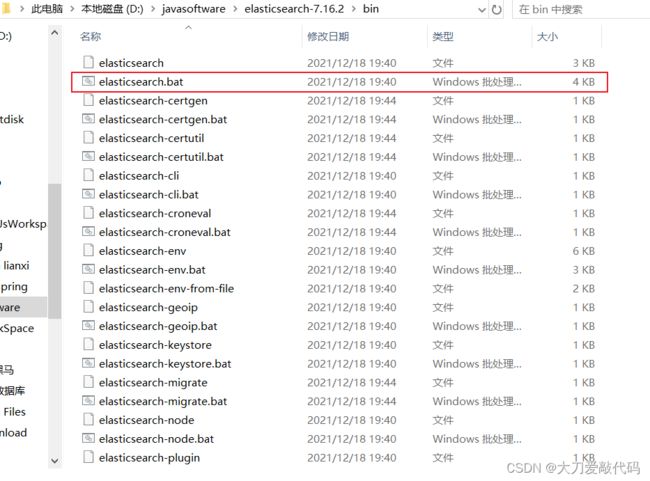
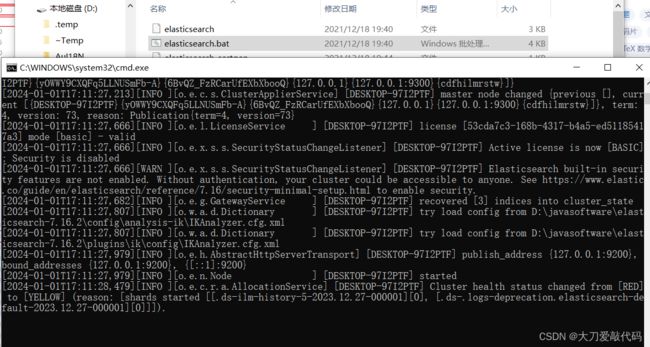
然后访问:http://localhost:9200/,看到下面的json数据后,表示es已经启动成功。

ES的基础操作
ES的基础操作-----索引操作
- 对于mysql数据库,我们一般需要创建数据库之后才能继续操作,而ES则需要创建索引之后才能继续操作。
- 对于es的操作,我们只需要发web请求就可以了。要操作ES可以通过Rest风格的请求来进行(因为它支持rest风格,可以使用postman进行操作),也就是说发送一个请求就可以执行一个操作。比如新建索引,删除索引这些操作都可以使用发送请求的形式来进行。
- ES中保存的数据,只是格式和数据库存储的数据格式 与我们的mysql等数据库不同而已。
- 在ES中我们要先创建倒排索引,这个索引的功能又有点类似于数据库的表。
- 然后将数据添加到倒排索引中,添加的数据称为文档。
- 所以要进行ES的操作要先创建索引,再添加文档,这样才能进行后续的查询操作。
不具备分词效果的索引的创建(没有指定分词器)
创建索引:注意这里使用的请求方式是put而不是post

获取索引
{
"book": {
"aliases": {},
"mappings": {},
"settings": {
"index": {
"routing": {
"allocation": {
"include": {
"_tier_preference": "data_content"
}
}
},
"number_of_shards": "1",
"provided_name": "book",
"creation_date": "1704103713618",
"number_of_replicas": "1",
"uuid": "1mabgD9eR7WvHVZeCBfVqw",
"version": {
"created": "7160299"
}
}
}
}
}
利用分词器进行创建索引(创建索引并指定分词器)
- 我们在创建索引时,可以添加请求参数,设置分词器。
- ik分词器的下载:https://github.com/medcl/elasticsearch-analysis-ik/releases
- 分词器下载后解压到ES安装目录的plugins目录中即可,安装分词器后需要重新启动ES服务器。使用IK分词器创建索引格式:
参数数据如下:
{
"mappings":{ //mapping表示:定义mappings属性,替换创建索引时对应的mappings属性
"properties":{ // properties表示:定义索引中包含的属性设置(属性是自定义的)
"id":{ // 设置索引中包含id属性(相当于数据库表中创建一个id字段)
"type":"keyword" //设置当前属性为关键字,可以被直接搜索
},
"name":{ // 设置索引中包含name属性
"type":"text", //设置当前属性是文本信息,参与分词
"analyzer":"ik_max_word", //选择当前属性的分词策略,这里表示使用IK分词器进行分词
"copy_to":"all" // 表示把分词结果拷贝到all属性中,即all属性中也有name属性同样的作用
},
"type":{
"type":"keyword"
},
"description":{
"type":"text",
"analyzer":"ik_max_word",
"copy_to":"all"
},
"all":{ //all是一个定义属性(虚拟的属性,数据库中不存在的属性),用来描述多个字段的分词结果集合,当前属性可以参与查询
"type":"text",
"analyzer":"ik_max_word"
}
}
}
}
查询带分词器的索引

返回值:(与前面的查询不带分词器的相比,会发现mappings里面多了很多数据信息)
{
"books": {
"aliases": {},
"mappings": { //mappings属性已经被替换
"properties": {
"all": {
"type": "text",
"analyzer": "ik_max_word"
},
"description": {
"type": "text",
"copy_to": [
"all"
],
"analyzer": "ik_max_word"
},
"id": {
"type": "keyword"
},
"name": {
"type": "text",
"copy_to": [
"all"
],
"analyzer": "ik_max_word"
},
"type": {
"type": "keyword"
}
}
},
"settings": {
"index": {
"routing": {
"allocation": {
"include": {
"_tier_preference": "data_content"
}
}
},
"number_of_shards": "1",
"provided_name": "books",
"creation_date": "1704103876876",
"number_of_replicas": "1",
"uuid": "nQ2Jmml6QSOGwOI2cswwJw",
"version": {
"created": "7160299"
}
}
}
}
}
ES的基础操作-----文档操作
- 前面我们已经创建了索引了,但是索引中还没有数据,所以要先添加数据,ES中称数据为文档,下面进行文档操作。
添加文档:
- 添加文档有三种方式:创建books索引下的文档
POST请求 http://localhost:9200/books/_doc #使用系统生成id(自动帮你创建)
POST请求 http://localhost:9200/books/_doc/1 #使用指定id,不存在创建,存在更新(版本递增)
POST请求 http://localhost:9200/books/_create/1 #使用指定id(必须指定id)
传参数据一般不使用id属性:因为指定了也不会生效,要么默认帮你创建,要么在请求路径上进行指定
参数的使用:
{
"id": 1, //一般不使用这一行
"name": "springboot1",
"type": "book",
"desctiption": "an book"
}
{
"_index": "books",
"_type": "_doc",
"_id": "MgeZxIwB35gR6M6IUssu",
"_version": 1,
"result": "created",
"_shards": {
"total": 2,
"successful": 1,
"failed": 0
},
"_seq_no": 1,
"_primary_term": 1
}
第二种请求方式:
{
"_index": "books",
"_type": "_doc",
"_id": "55",
"_version": 1,
"result": "created",
"_shards": {
"total": 2,
"successful": 1,
"failed": 0
},
"_seq_no": 2,
"_primary_term": 1
}
第三种请求方式:
返回结果:
{
"_index": "books",
"_type": "_doc",
"_id": "1",
"_version": 1,
"result": "created",
"_shards": {
"total": 2,
"successful": 1,
"failed": 0
},
"_seq_no": 0,
"_primary_term": 1
}
获取文档
- 根据id获取某个索引的文档:http://localhost:9200/books/_doc/1

- 获取某个索引的所有的文档:GET请求 http://localhost:9200/books/_search
GET请求 http://localhost:9200/books/_search?q=name:springboot
# q=查询属性名:查询属性值
删除文档
修改文档(分为全量更新和部分更新)
全量更新(注意这里是put请求,以及_doc)
- PUT请求 http://localhost:9200/books/_doc/1:根据指定id进行修改,传入的数据就是修改后的数据。
//文档通过请求参数传递,数据格式json
{
"name":"springboot",
"type":"springboot",
"description":"springboot"
}
修改文档(部分更新)注意:这里是post请求,以及_update
- POST请求 http://localhost:9200/books/_update/1
//文档通过请求参数传递,数据格式json
{
"doc":{ //部分更新并不是对原始文档进行更新,而是对原始文档对象中的doc属性中的指定属性更新
"name":"springboot" //仅更新提供的属性值,未提供的属性值不参与更新操作
}
}
三、Springboot整合ES
-
整合步骤(依旧是拿三板斧):
-
- 导入依赖
-
- 做配置(springboot底层有默认的配置)
-
- 调用它的api接口
-
-
ES有两种级别的客户端,一种是Low Level Client,一种是High Level Client。
- Low Level Client:这种客户端操作方式性能方面略显不足,不推荐使用,但是springboot最初整合ES的时候使用的是低级别客户端,所以企业开发需要更换成高级别的客户端模式。
- High Level Clien:高级别客户端与ES版本同步更新
Springboot整合Low Level Client的ES(不推荐使用了,这里了解一下)
- ES早期的操作方式如下:
步骤①:导入springboot整合ES的starter坐标(spiringboot里面有指定版本(就是低级别的版本号)
<dependency>
<groupId>org.springframework.bootgroupId>
<artifactId>spring-boot-starter-data-elasticsearchartifactId>
dependency>
步骤②:进行基础配置
spring:
elasticsearch:
rest:
uris: http://localhost:9200
配置ES服务器地址,端口9200(默认就是9200)
步骤③:使用springboot整合ES的专用客户端接口ElasticsearchRestTemplate来进行操作
@SpringBootTest
class Springboot18EsApplicationTests {
@Autowired
private ElasticsearchRestTemplate template;
}
springboot测试类中的测试类的初始化方法和销毁方法的使用
- @BeforeEach:在测试类中每个操作运行前运行的方法
- @AfterEach :在测试类中每个操作运行后运行的方法
@SpringBootTest
class Springbootests {
@BeforeEach //在测试类中每个操作运行前运行的方法
void setUp() {
//各种操作
}
@AfterEach //在测试类中每个操作运行后运行的方法
void tearDown() {
//各种操作
}
}
Springboot整合High Level Client的ES
- 高级别客户端方式进行springboot整合ES,操作步骤如下:
步骤①:导入springboot整合ES高级别客户端的坐标,此种形式目前没有对应的starter
<dependency>
<groupId>org.elasticsearch.clientgroupId>
<artifactId>elasticsearch-rest-high-level-clientartifactId>
dependency>
这里的springboot版本为:2.5.4,es的版本为7.16.2,那时候的springboot没有整合高级别的ES,所以配置文件里不需要配置,只能写硬编码配置
步骤②:使用编程的形式设置连接的ES服务器,并获取客户端对象
步骤③:使用客户端对象操作ES,例如创建索引,为索引添加文档等等操作。
ES-----创建客户端
@SpringBootTest
class Springboot18EsApplicationTests {
@Autowired
private BookMapper bookMapper;
private RestHighLevelClient client;
@Test
void testCreateClient() throws IOException {
//先创建ES客户端
HttpHost host = HttpHost.create("http://localhost:9200");
RestClientBuilder builder = RestClient.builder(host);
client = new RestHighLevelClient(builder);
client.close();
}
}
配置ES服务器地址与端口9200,记得客户端使用完毕需要手工关闭。由于当前客户端是手工维护的,因此不能通过自动装配的形式加载对象。
ES-----根据客户端创建索引
@SpringBootTest
class Springboot18EsApplicationTests {
@Autowired
private BookMapper bookMapper;
private RestHighLevelClient client;
@Test
void testCreateIndex() throws IOException {
//先创建ES客户端
HttpHost host = HttpHost.create("http://localhost:9200");
RestClientBuilder builder = RestClient.builder(host);
client = new RestHighLevelClient(builder);
//在通过ES客户端创建索引
CreateIndexRequest request = new CreateIndexRequest("books");
client.indices().create(request, RequestOptions.DEFAULT);
client.close();
}
}
高级别客户端操作是通过发送请求的方式完成所有操作的,ES针对各种不同的操作,设定了各式各样的请求对象,上例中创建索引的对象是CreateIndexRequest,其他操作也会有自己专用的Request对象。
ES-----根据客户端创建索引(使用Ik分词器)
使用分词器IK:
//json的参数:
{
"mappings":{
"properties":{
"id":{
"type":"keyword"
},
"name":{
"type":"text",
"analyzer":"ik_max_word",
"copy_to":"all"
},
"type":{
"type":"keyword"
},
"description":{
"type":"text",
"analyzer":"ik_max_word",
"copy_to":"all"
},
"all":{
"type":"text",
"analyzer":"ik_max_word"
}
}
}
}
@Test
void testCreateClientIndexByIk() throws IOException {
// 创建客户端
HttpHost host = HttpHost.create("http://localhost:9200");
RestClientBuilder builder = RestClient.builder(host);
client = new RestHighLevelClient(builder);
CreateIndexRequest request = new CreateIndexRequest("books");
String json = "{\n" +
" \"mappings\":{\n" +
" \"properties\":{\n" +
" \"id\":{\n" +
" \"type\":\"keyword\"\n" +
" },\n" +
" \"name\":{\n" +
" \"type\":\"text\",\n" +
" \"analyzer\":\"ik_max_word\",\n" +
" \"copy_to\":\"all\"\n" +
" },\n" +
" \"type\":{\n" +
" \"type\":\"keyword\"\n" +
" },\n" +
" \"description\":{\n" +
" \"type\":\"text\",\n" +
" \"analyzer\":\"ik_max_word\",\n" +
" \"copy_to\":\"all\"\n" +
" },\n" +
" \"all\":{\n" +
" \"type\":\"text\",\n" +
" \"analyzer\":\"ik_max_word\"\n" +
" }\n" +
" }\n" +
" }\n" +
"}";
//设置请求中的参数(添加分词器)
request.source(json, XContentType.JSON);
client.indices().create(request, RequestOptions.DEFAULT);
client.close();
}
IK分词器是通过请求参数的形式进行设置的,设置请求参数使用request对象中的source方法进行设置,至于参数是什么,取决于你的操作种类。当请求中需要参数时,均可使用当前形式进行参数设置。
ES-----为索引添加文档
// 添加文档:
@Test
void testCreateClientIndexByIkAddData() throws IOException {
// 创建客户端
HttpHost host = HttpHost.create("http://localhost:9200");
RestClientBuilder builder = RestClient.builder(host);
client = new RestHighLevelClient(builder);
// 进行添加操作,因为前面已经创建好了books索引
Book book = bookMapper.selectById(1);
// 把book对象数据转换为json数据,
String json = JSON.toJSONString(book);
// 指定添加的文档的id为book.getId(),需要添加文档的索引为books
IndexRequest request = new IndexRequest("books").id(book.getId().toString());
// 传入数据
request.source(json,XContentType.JSON);
client.index(request,RequestOptions.DEFAULT);
client.close();
}
添加文档使用的请求对象是IndexRequest,与创建索引使用的请求对象不同。
ES-----为索引批量添加文档
// 批量添加
@Test
void testCreateClientIndexByIkAddBatchData() throws IOException {
// 创建客户端
HttpHost host = HttpHost.create("http://localhost:9200");
RestClientBuilder builder = RestClient.builder(host);
client = new RestHighLevelClient(builder);
// 进行添加操作,因为前面已经创建好了books索引
List<Book> bookList= bookMapper.selectList(null);
// BulkRequest的对象,可以将该对象理解为是一个保存request对象的容器,
// 将所有的请求都初始化好后,添加到BulkRequest对象中,再使用BulkRequest对象的bulk方法,一次性执行完毕
BulkRequest bulk = new BulkRequest();
for (Book book : bookList) {
// 把book对象数据转换为json数据,
String json = JSON.toJSONString(book);
// 指定添加的文档的id为book.getId(),需要添加文档的索引为books
IndexRequest request = new IndexRequest("books").id(book.getId().toString());
// 传入数据
request.source(json,XContentType.JSON);
// 把数据放进BulkRequest对象里面
bulk.add(request);
}
// 批量执行
client.bulk(bulk,RequestOptions.DEFAULT);
// 关闭客户端
client.close();
}
批量做时,先创建一个BulkRequest的对象,可以将该对象理解为是一个保存request对象的容器,将所有的请求都初始化好后,添加到BulkRequest对象中,再使用BulkRequest对象的bulk方法,一次性执行完毕。
ES-----查询文档
根据id查询
@Test
//按id查询
void testGetById() throws IOException {
// 创建客户端
HttpHost host = HttpHost.create("http://localhost:9200");
RestClientBuilder builder = RestClient.builder(host);
client = new RestHighLevelClient(builder);
// 根据id查询
GetRequest request = new GetRequest("books","1");
GetResponse response = client.get(request, RequestOptions.DEFAULT);
// 获取查询到的数据中的source属性的数据
String json = response.getSourceAsString();
System.out.println(json);
client.close();
}
条件查询
@Test
//按条件查询
void testSearch() throws IOException {
// 创建客户端
HttpHost host = HttpHost.create("http://localhost:9200");
RestClientBuilder builder = RestClient.builder(host);
client = new RestHighLevelClient(builder);
//
SearchRequest request = new SearchRequest("books");
//创建条件查询对象
SearchSourceBuilder searchSourceBuilder = new SearchSourceBuilder();
// 设置查询条件
searchSourceBuilder.query(QueryBuilders.termQuery("all", "spring"));
// 把查询条件放进请求中
request.source(searchSourceBuilder);
// 根据请求获取返回数据
SearchResponse response = client.search(request, RequestOptions.DEFAULT);
// 获取返回数据里面的hits属性(获取的具体属性,可以看上面的postman操作)
SearchHits hits = response.getHits();
for (SearchHit hit : hits) {
String source = hit.getSourceAsString();
//把json数据转换为对象
Book book = JSON.parseObject(source, Book.class);
System.out.println(book);
}
}
Mysql与Es数据同步的实现(这里只是基本了解一下)
- 在实际项目开发中,我们经常将mysql作为业务数据库,ES作为擦汗寻数据库,用来实现读写分离,缓解mysql数据库的查询压力,应对海量数据的复杂查询。
1、同步双写
- 这是一种最为简单的方式,在将数据写入mysql的同时,也把数据写到ES里面
- 优缺点:
- 优点
-
- 业务逻辑简单
- 2、 实时性高
-
- 缺点:
-
- 硬编码,有需要写入MySQL的地方,都需要添加写入es的代码
-
- 业务强耦合
-
- 存在双写失败丢失数据的风险
-
- 性能较差,本来的mysql的性能不是很高,再加一个es系统的性能必然会下降
-
- 优点
2. 异步双写
- 针对多数据源写入的场景,可以借助MQ实现异步的多源写入
- 优缺点
- 优点:
-
- 性能高
-
- 不易出现数据丢失问题:主要基于MQ消息的消费保障机制,比如ES宕机或者写入失败,还能重新消费MQ消息;
-
- 多源写入之间相互隔离,便于扩展更多的数据源写入
-
- 缺点:
-
- 硬编码问题:接入新的数据源需要实现新的消费者代码
- 2、系统复杂度增加,映入了消息中间件
- 3、数据实时问题,mq是异步消费,用户输入,不一定会马上同步让他看到
-
- 优点:
3、基于sql抽取(定时任务)
- 上面两种方案都存在硬编码问题,代码的侵入性太强,如果对实时性要求不高的情况下,可以考虑用定时器来处理:
-
- 数据库的相关表中增加一个字段为updatetime(自己定义的名称)字段,任何CURD操作都会导致该字段的实际发生变化
-
- 原来程序中的crud操作不做任何变化
-
- 增加一个定时器程序,让该程序按一定的时间周期扫描指定的表,把该时间段内发生的变化的数据提取出来
-
- 比较此字段来确认变更数据,然后把变更的数据逐条写入ES中。
-
- 优缺点:
- 优点:
- 1、不改原代码,没有侵入性,没有硬编码;
- 2、没有业务强耦合,不改变原来程序的性能;
- 3、worker代码编写简单,不需要考虑增删改查;
- 缺点:
- 1、时效性太差,由于采取定时器根据固定频率查询表来同步数据,尽管将同步周期设置到秒级,也还是会存在一定时间的延迟。
- 2、对数据库有一定的轮询压力。
- 优化的方案:
- 1、将轮寻放到压力不大的从库上
- 2、借助logstash实现数据同步,其底层实现原理就是根据配置定期使用sql查询新增的数据写入es中,实现数据的增量同步(经典方案)
- 优点:
4、基于Binlog实现同步
-
前三种代码要么有代码侵入,要么有延迟。
-
而基于Binlog与mysql实现同步:既能保证数据同步的实时性又没有代入、侵入性。
-
实施步骤
- 1、读取mysql 的binlog日志,获取指定表的日志信息;
- 2、将读取的信息转为mq;
- 3、编写一个mq消费程序;
- 4、不断消费mq,每费完一条消息,将消息写入到es中;
-
优缺点:
- 优点:
- 1、没有代码侵入,没有硬编码;
- 原有系统不需要任何变化,没有感知;
- 3、性能高
- 4、业务解耦,不需要关注原来系统的业务逻辑
- 缺点:
- 1、构建Binlog系统复杂
- 2、如皋采用MQ消费解析的Binlog信息,也会存在MQ延时的风险
- 优点:
数据迁移工具选型
- 对于上面的四种数据同步方案,“基于Binlog实时同步”方案是目前最为常用的,也诞生了很多优秀的数据迁移工具,主要有以下几种:
- 1、canal (原理是伪装成mysql的从数据库)
- 2、阿里云DTS (需付费)
- 3、databus
- 4、Flink
- 5、CloudCanal
- 6、Maxwell


